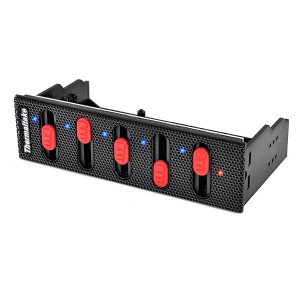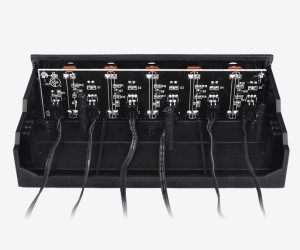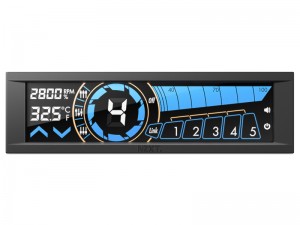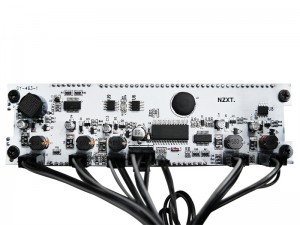The Thermaltake Commander F5 is a manual slider-style fan controller. It is a 5-channel, 8 watt per channel unit that is compatible with 3-pin and 4-pin fans, and it will fit into any 5.25-inch drive bay. Thermaltake obviously intended this as a budget-priced fan controller (as of this writing, it was selling for $26.34 on Amazon, although some sellers had it for about $20), and more budget-conscious consumers expecting a high-quality product from Thermaltake will undoubtedly consider this controller. But does it live up to the Thermaltake reputation for quality? We shall see.
The Thermaltake Commander F5 is packaged in a cardboard box with a large image of the controller. The bottom of the box lists six features of the unit (among other things, a mesh grille design and 5 independent sliders), a specifications chart, and six images covering some of the listed features.
When you open the box, you will find the controller wrapped in an anti-static bag with foam on either side of it to keep it in place. Removing the controller from the packaging reveals the installation guide, warranty policy flier, and four installation screws, as well as the cables, neatly tucked into the back of the controller. Since the cables are already connected, this also eliminates having to plug them in. The back of the Commander F5 is made of sturdy-looking black plastic. Looking at the front of the unit, you can see blue LEDs nect to each of the five sliders, as well as a red LED that servers as a power indicator on the far right of the controller.
Moving once again to the back of the controller, the back of the PCB is exposed. Here you will see a few resistors and the solder points from the LEDs. In addition, the fan headers are fit against the floor of the controller to keep them from coming loose. There are 5 cables for the fans, marked appropriately 1 through 5, and all of them are 4-pin ready, although it should be noted that this fan controller will not work with 4-pin Molex fans. There is also a 4-pin Molex connector for powering the unit.
Installation of the Commander F5 is relatively easy, although the power cable is a bit short (100 mm). If you have a full-sized tower, connecting the controller to the power supply may be a bit of a challenge. If a fan is connected to each channel, then when the computer is booted, all 5 blue LEDs will light up. Even without any connected fans, the red LED will light up to show you the controller is powered. The LEDs are quite bright, however, which may be an issue if your computer is in your bedroom.
Controlling the fans entails simply moving the slider for each channel. The lowest setting for each channel delivers 4 volts. Most voltage-controlled fans shut off around 5 volts, so this should enable you to shut off such fans. Unfortunately, when the slider is turned all the way up, it only delivers 10.5 to 11 volts. This will limit the amount of noise, but it also limits the maximum speed to about 85 percent of what it could be.
In conclusion, the Thermaltake Commander F5 is somewhat of a mixed bag. On the one hand, it is aesthetically pleasing and relatively inexpensive. But the fact that the maximum voltage is less than 12 volts is a bit of a drawback. In addition, the fan connectors are somewhat cheap-looking, and the controller only provides 8 watts per channel, so you can pretty much forget about connecting multiple fans to a single channel. In my opinion, the budget price only goes so far, and budget-conscious consumers might be better off spending a few dollars more and buying the Sunbeamtech PL-RS-6 Rheosmart 6. The Rheosmart 6 is also a manual controller, but has 6 channels at 30 watts per channel. If the F5 were modified to provide 12 volts maximum output, I could give it at least a qualified endorsement, but in its current form, I am inclined to give it a thumbs down.
Specifications:
P/N: AC-001-BN1NAN-A1
Compatibility: 5.25” Driver bay
Weight: 185g
Dimension: 150 x 80 x 42 mm
Material: Plastic & Mesh
Main Function: Manual Fan Speed Controller
Color: Black
Cable Length: Power cable: 100mm; Fan cable : 600mm
Connector: 3-Pin x 5 ; 4-Pin power cable
DC Input: +12V
DC Output Range: 4V – 10.5V
Watts per Channel: 8W
External Links:




Recent Comments